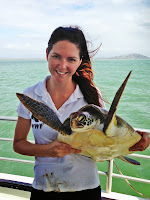By Christine Hof,
Species Conservation Project Coordinator WWF Australia
I
remember many years ago swimming with turtles on the Great Barrier Reef. Through
this experience I was transported into their world, the underwater world and I
was hooked!
Fast
forward 10 years and I’m now part of that world. And while I know a lot more
about marine life – there is still much to explore and to learn.
So
that’s why last week I was one and half hours south of Townsville, surrounded
by the waters of Upstart Bay. Along a 15km stretch of beach - Wunjunga beach - flatback
turtles, Australia’s only endemic marine turtle, come to nest.
The
problem is we just don’t know enough about flatback turtles and their
whereabouts in the northern Great Barrier Reef. Once they nest, it seems they
disappear into our oceanic waters, without a trace. Where do they travel? Where
do they forage? What threats do they face?
So
how can we find out more?
Through
satellite transmitters!
Last
week WWF, with our partners, attached satellite transmitters onto four
flatbacks. Thanks to one of our supporting partners, Factorie, these devices will allow
us to monitor the whereabouts of these little known turtles that originate from
Wunjunga beach.
Like many innovative projects, this is a collaboration between universities, government, Indigenous and volunteer community groups. Over time, the partners will continue to view the turtles’ movements. And so can you! Go to SeaTurtle.org to follow the turtle tracks
As
we were on the sea country of the Juru people, the Gudjuda Reference
Group was asked to name one of the turtles. They chose Gudjuda.
It
is hoped that the tracking information will provide rare insight into the world
of the Flatback, and the threats that they may face. We’ll be sure to keep you
updated on the results. To follow the project check out the research page on OIQ and the WWF flatback turtle page




No comments:
Post a Comment